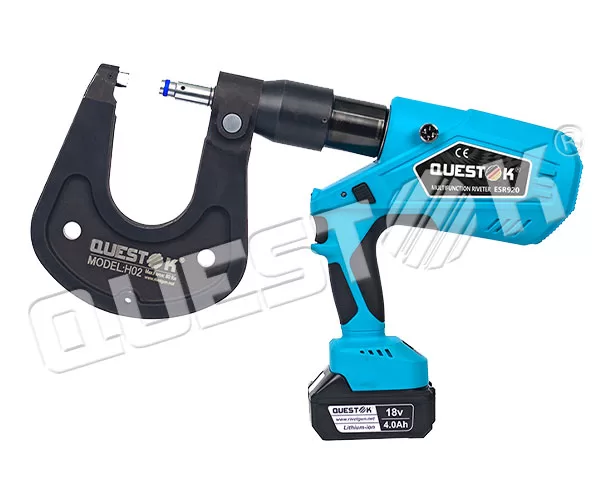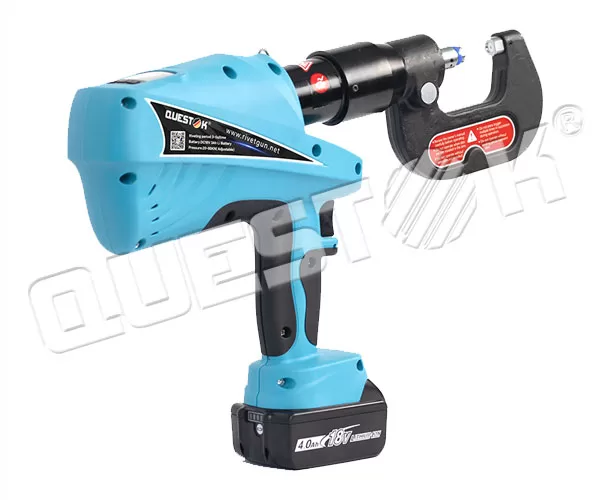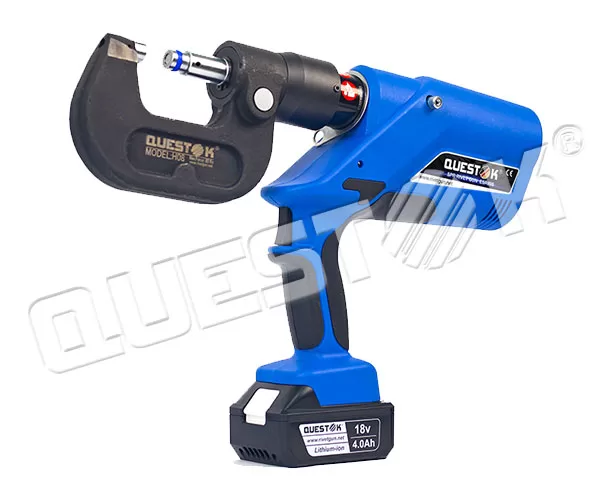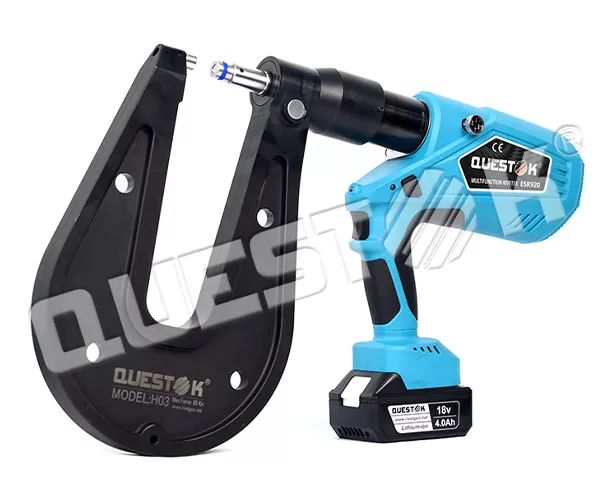How Self-Piercing Rivet (SPR) Guns Boost Productivity ?
Questok self-piercing rivet (SPR) gun is a specialized tool designed to join or fasten materials together using self-piercing rivets. Self-piercing rivets are mechanical fasteners that do not require pre-drilled holes like traditional rivets or screws. Instead, they are specifically designed to pierce and join layers of material in one step. SPR guns facilitate the insertion and installation of these rivets, making them an essential tool in various industries that require efficient and reliable fastening. Self-piercing rivet (SPR) guns are useful in a variety of fields, making it easy to achieve high-quality fastening at all stages of the production process, whether metal, plastic or composite. Today, the SPR gun is more than a simple tool, it represents a more efficient and environmentally friendly production method.
In manufacturing, the use of SPR guns can help manufacturers reduce costs and increase production efficiency. Self-piercing rivet guns can reduce drilling time, improve material utilization, and reduce waste. At the same time, metal connections made with SPR guns are stronger, more durable, and easier to maintain than traditional bolted connections. In the aerospace field, SPR guns also have a wide range of applications. In aircraft construction and repair, SPR guns provide a safe and convenient method for joining dissimilar metallic materials such as aluminum and steel. In the construction industry, SPR guns are widely used in the joining of building panels, making the production process of joints more efficient.
With the advancement of technology, the operation of SPR guns is more convenient and the design is more user-friendly. User-friendly equipment can reduce the operator’s learning costs and improve work efficiency. In addition to this, the new SPR gun is also equipped with a series of intelligent functions, such as automatic calibration, real-time feedback and fault diagnosis, making the operation safer and more reliable. With the continuous application and updating of new technologies, Questok SPR guns will surely play a more important rolSelf-Piercing Riveting (SPR)e in future production and construction.
What Is Self-Piercing Riveting (SPR) ?
It is a method used to connect sheet materials using rivets, where the rivet is driven into the sheets to clamp them together. Unlike traditional riveting, no pre-drilled holes are required, making it a fast single-step process. Typically, during rivet insertion, the first sheet is pierced, and then as the rivet gets jammed into the second sheet, the second sheet deforms into a button. This process is similar to riveting, but instead of using rivets, the punch deforms the sheets into interlocking buttons.
Through SPR, the sheets are deformed by being held in place by the rivet and form an interlock between them. However, SPR requires access to both sides of the joint. Start by clamping the sheets between a die and an anvil. Then, use a punching tool to drive the rivet through the sheets, piercing the top sheet and causing the bottom sheet to expand into the die. The shape of the die causes the rivet and the bottom sheet to flare outwards, creating a mechanical interlock.
The rivet head can be flush with the top sheet, but the bottom sheet will always protrude to form a button, which usually isn’t pierced. SPR comes in various proprietary processes and often utilizes semi-hollow rivets, though solid rivets are sometimes used as well. Unlike welding, SPR can be used to join dissimilar metals or materials that are not weldable. This has become increasingly important in the automotive industry where combinations of aluminum and steel sheets are used. As a result, SPR is being employed in certain vehicle designs as a replacement for spot welding. SPR is an effective method for joining parts made of aluminum, steel, plastic, or composite materials.
Other advantages include no smoke or sparks, no need for material heating, low noise, and low energy consumption. It is also suitable for pre-coated materials that are not conducive to welding. For example, blind rivets are used in body assembly, where restricted access allows for joint access from only one side. In such cases, the benefits of SPR are null since access from both sides is required to form the rivet upset.
The Types of Self-Piercing Rivet (SPR) Gun
- Hand-Held SPR Gun:
Questok Hand-held SPR guns are portable and versatile tools commonly used for smaller-scale applications. They are suitable for manual operations where mobility and flexibility are essential. These guns are often used in workshops, repair shops, and small-scale manufacturing environments. The DSR920B Hand-Held Rivet Gun is a specific model of a portable tool designed for fastening materials using various types of rivets. This type of tool is commonly used in various industries, including construction, automotive, manufacturing, and more. The DSR920B model is likely designed to accommodate specific rivet sizes and materials, offering ease of use and efficiency for a range of applications.

Hand-held rivet guns are designed to be lightweight and portable, allowing for easy maneuverability and use in various locations. Comfortable grip and ergonomic design ensure ease of use and reduced operator fatigue during prolonged use. These tools can typically handle a variety of rivet sizes and materials, making them suitable for different fastening tasks. Besides, The DSR920B model is likely optimized for specific rivet sizes, which might be indicated in the product specifications or user manual. Hand-held rivet guns streamline the fastening process by reducing the need for manual hammering or other labor-intensive methods.
2. Battery-Operated Pop Rivet Gun
Our battery-operated pop rivet gun DSR880A is a convenient and portable tool designed for fastening materials using pop rivets. Unlike traditional rivet guns that require manual squeezing or hammering, battery-operated pop rivet guns automate the process, making it quicker and easier for users to secure materials together. These tools are commonly used in various industries for tasks that involve joining metal sheets, fabricating structures, assembling products, and more. For one thing, Questok Battery-operated pop rivet guns are cordless, allowing users to work in locations where power outlets might be inaccessible or inconvenient. They can accommodate a range of pop rivet sizes, making them suitable for various applications and materials. For another, Unlike pneumatic rivet guns, which require an air compressor, battery-operated guns are self-contained, eliminating the need for additional equipment.

3. Electric Aluminium Rivet Gun
In the realm of modern manufacturing and construction, the quest for efficiency, precision, and ease of operation has led to remarkable innovations. Among these innovations stands the electric aluminum rivet gun, a tool that has revolutionized the process of fastening aluminum rivets. Questok electric aluminum rivet gun is a tool designed to fasten aluminum rivets using electric power. These tools automate the process of riveting, making it easier, quicker, and more efficient compared to manual riveting methods. Electric aluminum rivet guns are commonly used in various industries, including manufacturing, construction, automotive, and more.

The art of joining materials has evolved over centuries, and riveting remains a fundamental technique. The advent of electric aluminum rivet guns, however, has propelled riveting into the future by automating a historically manual process. These guns exemplify the fusion of technology and craftsmanship, bridging the gap between traditional techniques and modern demands. At the heart of an electric aluminum rivet gun lies a combination of engineering marvels. The tool is designed to effortlessly secure aluminum rivets through a controlled and automated process. The operational sequence typically involves:
Alignment: The operator positions the tool over the intended rivet location, ensuring precise alignment.
Trigger Activation: With a simple pull of the trigger, the electric motor within the gun initiates the riveting process.
Rivet Insertion: The tool automatically drives the aluminum rivet through the materials, using controlled force to create a secure connection.
Mandrel Separation: Electric aluminum rivet guns often feature mechanisms to detach and collect the mandrel, maintaining a clean workspace.
Repeatable Precision: The automated nature of the process ensures consistent force application, minimizing the risk of over-compression or material damage.
4. Battery Operated Rivet Gun
Questok Battery-operated rivet guns are portable tools designed to quickly and easily fasten rivets without the need for manual force. They are commonly used in various industries, including automotive, construction, aerospace, and manufacturing, where rivets are used to join materials together. These tools are powered by rechargeable batteries, which provide the necessary force to drive the rivet through the materials being joined. Battery-operated rivet guns offer several advantages over traditional manual rivet tools: Battery-operated rivet guns are faster and more efficient compared to manual riveting. They can set rivets with consistent force and speed, leading to improved productivity and These tools are cordless and lightweight, allowing for easy movement and use in different locations. This makes them particularly useful for on-site work and in tight spaces.

Manual riveting can be physically demanding and tiring, especially for large-scale projects. Battery-operated rivet guns reduce the strain on operators and minimize the risk of repetitive stress injuries. When considering a battery-operated rivet gun, it’s important to choose a tool that suits your specific needs in terms of the types of materials you’ll be working with, the sizes of rivets you’ll be using, and the frequency of use. Additionally, always follow the our instructions for proper use, maintenance, and safety precautions. As technology continues to advance, electric aluminum rivet guns are poised to undergo further refinement. Innovations might include enhanced automation features, smart connectivity for data analysis, and improved power efficiency. The integration of these tools into emerging manufacturing paradigms ensures that the art of riveting continues to evolve, paving the way for a future where fastening is both efficient and precise.
How SPR Guns Enhance Structural Integrity in Manufacturing ?
SPR guns play a crucial role in enhancing structural integrity through their efficient and reliable joining capabilities. Self-Piercing Riveting (SPR) technology, facilitated by these specialized tools, offers several advantages that contribute to improved structural strength in various industries. Structural integrity is a paramount concern in manufacturing, where the reliability and safety of products depend on robust connections. In recent years, Self-Piercing Rivet (SPR) guns have emerged as game-changers in the pursuit of superior structural strength. A comparison between traditional joining methods and the unique advantages offered by SPR guns in terms of creating solid and reliable connections. The strength and reliability of connections between materials are of paramount importance. Traditionally, joining methods such as welding, screws, and bolts have been relied upon for these purposes. However, the advent of Self-Piercing Rivet (SPR) guns has introduced a new era of connection technology.
Questok SPR guns create consistent and uniform joints, minimizing variations that might arise from manual riveting or welding processes. This uniformity translates to enhanced structural stability and load-bearing capacity. The interlocking button formed by SPR ensures a secure connection between the joined materials. This button-like structure distributes loads more evenly, reducing stress concentrations and enhancing the overall integrity of the joint. SPR guns excel in joining dissimilar materials, such as aluminum and steel, which are commonly found in modern lightweight vehicle manufacturing. This ability to create strong connections between materials with different properties contributes to the overall structural soundness of the assembled components.
SPR guns streamline the assembly process by eliminating the need for pre-drilled holes or additional welding steps. The speed and efficiency of SPR contribute to quicker production cycles without compromising joint quality. Besides, SPR joints can maintain better corrosion resistance compared to welded joints, as the absence of heat minimizes the alteration of material properties that can lead to accelerated corrosion. Due to their ability to create strong, durable, and reliable joints with a range of materials contributes significantly to the overall safety, performance, and longevity of assembled structures and components.
Concluding with a look to the future, where SPR guns are poised to play an even more significant role in achieving manufacturing excellence through boosted productivity. By shedding light on the ways in which SPR guns optimize production processes, this article aims to underscore their pivotal role in enhancing productivity, reducing assembly times, and ultimately contributing to the growth and success of modern manufacturing industries.
- Company News
- Industry News
- Tag
- Tags
-
The Advantages of Questok Rivet Guns: Precision, Efficiency, and Durability
In industrial fastening applications, the choice of tools directly impacts productivity, safety, and long-term cost-effectiveness. Questok rivet guns have emerged as a standout solution for professionals across aerospace, automotive, and construction sectors. Combining advanced engineering with user-centric design, these tools deliver unmatched performance. Below are the key advantages that make Questok rivet guns a preferred choice:
-
Rivet Gun FAQ
Rivet Gun FAQ-SPR
-
Fast Assembly and Repair With Cordless Solid Rivet Gun
Questok cordless solid rivet gun stands out as a pivotal innovation, merging portability with power to facilitate efficient and effective fastening in a myriad of applications.
-
Redifine The Role of Self-piercing Riveting Gun Machine
Self-piercing riveting adopts high-speed mechanical fastening skill that joins thin sheet materials, typically steel and aluminum alloys.
-
The Latest Innovations in Clinching Tool Design
Explore the latest innovations in clinching tool design, redefining precision, efficiency, and versatility in material joining.
-
The Application and Maintenance of Self-Piercing Rivet Guns
Delve into the applications of self-piercing rivet guns in the automotive and aerospace industries and reveal the essential maintenance practices that ensure their accuracy and efficiency.
-
Rivetless Riveting Gun for Ventilation Duct Projects
The ventilation duct rivetless gun is a tool for riveting ventilation ducts without rivets.
-
Guide to Using Self-Piercing SPR Riveting Gun
In the automotive industry, self-piercing SPR (Self-Piercing Rivet) riveting guns are commonly used for joining metal components in vehicle bodies, including BMW vehicles.
-
Rivet Gun FAQ
Rivet Gun FAQ-SPR
-
Versatile Fastening- Applications of the Handheld Rivet Gun Across Industries
In the realm of fastening, the handheld rivet gun stands as a testament to ingenuity and versatility. Its ability to effortlessly join materials with sheer strength and permanence has revolutionized manufacturing and construction processes, leaving an enduring mark on diverse industries. Aerospace: Where precision and reliability are paramount, the rivet gun shines. In aircraft assembly, […]
-
Time-Saving Tools- Speeding Up Projects with Electric Blind Rivet Guns
In the whirlwind of project deadlines, every minute counts. But what if there was a tool that could dramatically reduce assembly time, giving you an edge in the race against the clock? Enter the electric blind rivet gun: your secret weapon for lightning-fast and effortless riveting. Electric blind rivet guns are the ultimate time-savers for […]
-
Streamlining Fastening- How an Electric Blind Rivet Gun Enhances Efficiency
Introduction In the realm of manufacturing and assembly, fastening plays a crucial role in securing components and ensuring structural integrity. Traditional manual rivet guns, while reliable, are often time-consuming and labor-intensive. The advent of electric blind rivet guns has revolutionized the fastening process, significantly enhancing efficiency and productivity. This article delves into the benefits of […]
-
The Role of Automation in Electric Rivetless Clinching
Electric rivetless clinching (ERC) is a lightweight joining process that eliminates the need for rivets or other fasteners. This can lead to significant cost savings and increased production efficiency. Automation plays a critical role in ERC, enabling high-speed and high-volume production. Automated Feed Systems Automated feed systems are used to accurately position the two workpieces […]
-
Why Choose a Universal Self-Piercing Riveting Gun for Your Projects?
In the realm of construction and fabrication, riveting guns stand as indispensable tools for creating secure and robust connections. Among the various types available, universal self-piercing riveting (SPR) guns have emerged as a game-changer due to their versatility and efficiency. This article will delve into the compelling reasons why choosing a universal self-piercing riveting gun […]
-
Why Choose Stainless Steel Hollow Rivets for Your Projects?
In the world of industrial manufacturing, choosing the right fasteners for your projects is crucial for ensuring longevity and reliability. Among the many options available, stainless steel hollow rivets stand out as a superior choice for a wide range of applications. This article delves into the compelling reasons why stainless steel hollow rivets are the […]
-
Top Trends in Electric Rivetless Clinching Guns
In the realm of fastening technology, electric rivetless clinching guns have emerged as a revolutionary solution for a wide range of industrial applications. These advanced tools offer several преимущества and capabilities, revolutionizing the way businesses approach their fastening needs. Adoption of Brushless Motors Brushless motors have gained significant traction in electric rivetless clinching guns due […]







